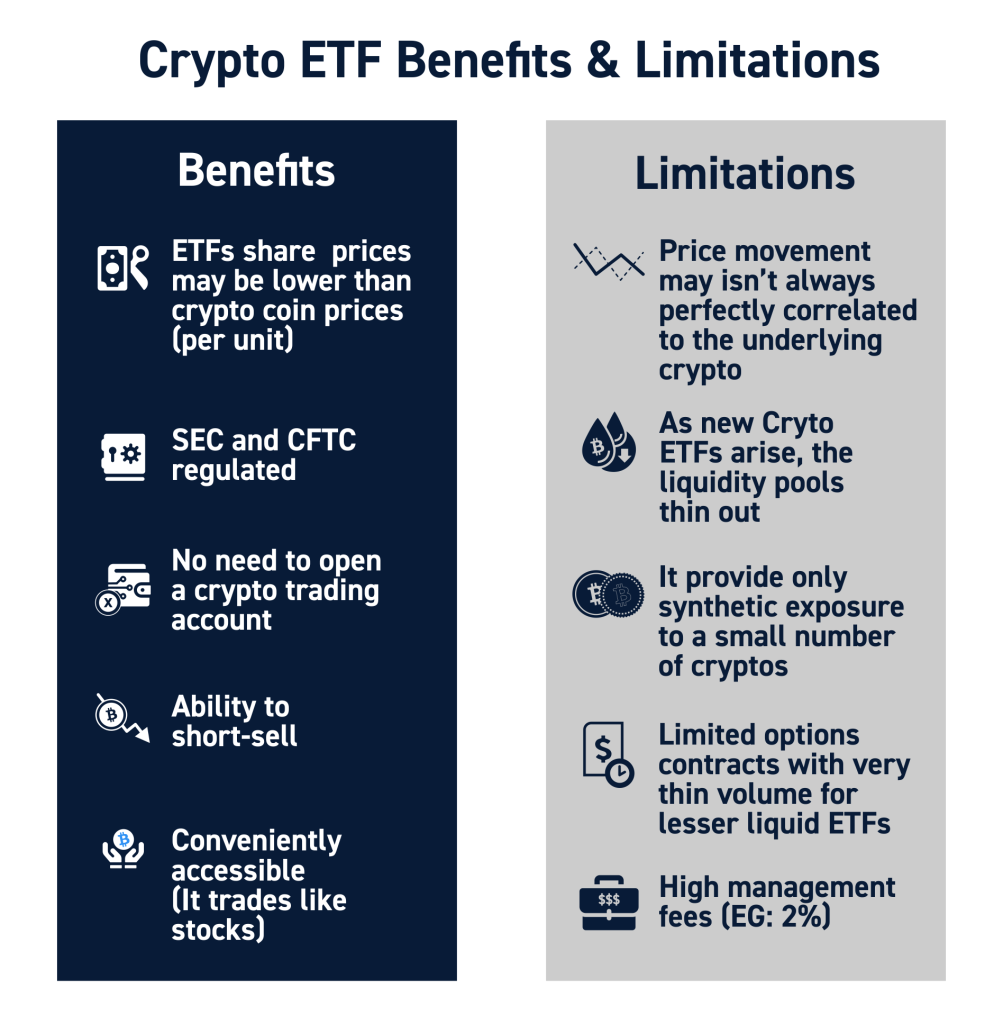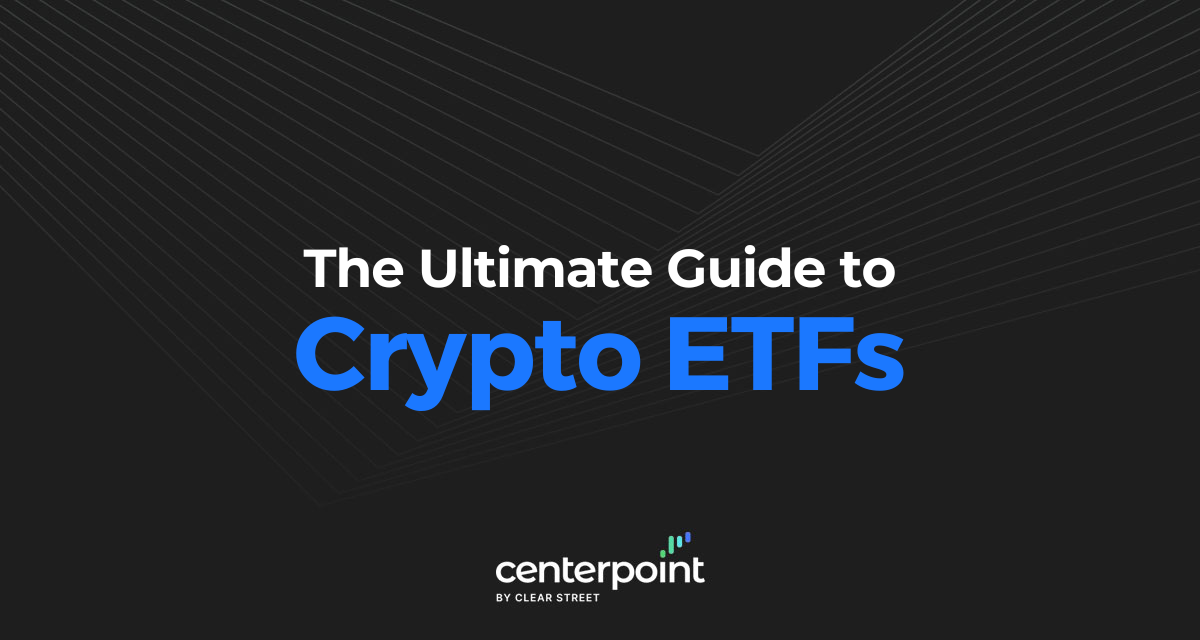For years big mutual fund companies have been trying to get approval for cryptocurrency exchange-traded-funds (ETFs) to no avail. The U.S. Securities and Enforcement Commission has been reluctant to approve ETFs for this risky asset class. However, the SEC finally approved futures-based crypto ETFs starting in October 2021.
What is a Crypto ETF?
A crypto ETF enables traders and investors to trade the underlying cryptocurrency on the U.S. stock exchanges. A crypto ETF aims to mirror the price movement of the underlying cryptocurrency. Currently, this is done by using futures contracts rather than buying the actual asset. As the SEC approves fully fledged crypto ETFs, they may eventually buy the cryptocurrencies much like stock ETFs.
ETFs are also created to stabilize and buffer the volatility of the underlying asset while providing transparency due to its required SEC filings.

Why Would Someone Trade a Crypto ETF?
Traders looking for general exposure in the crypto markets without the complications of opening another account are ideal for crypto ETFs. Crypto ETFs enable traders to get access conveniently in a stock brokerage account as an ETF.
Stock traders can feel more comfortable with an ETF as opposed to trading the actual crypto and dealing with the spreads, commissions, and slippage.
To put it simply, equities traders may trade crypto ETFs when they want exposure to crypto markets without the hassle of setting up a digital wallet or a new account at a crypto exchange.

Short Crypto Markets
Another one of the key aspects of trading crypto ETFs is the ability to short them. This can be a directional play for lower prices or a hedge against long crypto positions. The ability to short enables the freedom of playing both sides of the trade and that makes crypto ETFs incredibly appealing even if you are trading the underlying cryptos with a broker or through an exchange.
How Does a Crypto ETF Work?
Currently, unlike conventional ETFs that own the underlying asset outright, crypto ETFs either own the crypto futures, crypto stocks (i.e. miners), or other crypto-based instruments. The goal is to mimic the movements of the underlying crypto currency.
What assets does the crypto ETF hold?
Crypto ETFs can hold a combination of crypto futures, options, and or stocks involved in crypto sector including miners or holders. Currently, ETFs are not approved to hold the actual cryptocurrencies as they are still considered too risky. Since they don’t actually hold the cryptocurrencies, there could be times where the ETF movements don’t correspond completely with the crypto. These ETFs mirror the derivatives, not the exact crypto. However, futures contracts will rarely diverge with the underlying cryptos for an extended duration of time.
How is value determined?
Like any ETF, the net asset value is based on the real time calculation of its assets. Every ETF explains how the fund calculates its valuation, so its best to read the prospectus whenever considering trading or investing in them.
How is price controlled?
The price fluctuations in a crypto ETF are affected by the underlying assets. In an ideal world, a 5% movement in Bitcoin would result in a 5% movement in a Bitcoin ETF. Due to the unregulated nature of cryptos, especially alt coins, there can be periods of price discovery slippage and even errors. Sharp moves in the crypto assets can cause a delayed reaction in the crypto ETF depending on how the derivatives like futures and options prices react.
Benefits and Limitations of Crypto ETFs

Benefits
Crypto ETFs have unique benefits.
First off, they enable anyone to get exposure to the crypto market. Traders can trade crypto during periods of volatility without having to open a crypto trading account and undertake the expenses of such
Crypto ETFs are conveniently accessible through your existing stock trading platform since they trade just like stocks. Traders won’t really notice the management fees or have to deal with execution, spreads, commissions and all the little hidden fees that accompany cryptocurrency trading on an exchange.
Since they are registered securities, they are regulated by the SEC and the CFTC. They are required to make regular filings of their holdings.
One of the main benefits is the ability to short-sell the ETF in order to capitalize on falling crypto prices or act as a hedge to long positions. Crypto ETFs can be as volatile as the underlying crypto, but that volatility may be contained since the ETFs trade at a cheaper price. For example, a crypto may trade at $50,000 but the ETF trades at $30, therefore making a 2% price move less impactful on the ETF ($0.60) versus the actual crypto ($1,000).
Limitations
There are limitations associated with trading crypto ETFs.
First, crypto ETFs may not accurately reflect the underlying crypto exactly tick for tick. In fact, there will be periods where they may diverge with the underlying crypto due to backwardation and liquidity. Keep in mind that ETFs “attempt” to mimic the underlying financial instruments, they don’t guarantee exact tick for tick movement.
The ETFs have language in its prospectus that covers them completely, so don’t assume the ETF completely replaces the crypto. Furthermore, crypto ETFs currently only provide synthetic exposure to a small number of cryptos.
Alt coins for the most part are not included with the more liquid crypto ETFs. Liquidity is also a factor as with all ETFs, the popular crypto ETFs inherit the most liquidity and as new ETFs arise, the liquidity pools thin out. The lesser liquid ETFs may also have limited options contracts with very thin volume. Crypto ETFs also have relatively high management fees (EG: 2%) which can add up over time. While they are ideal for short-term speculation, the management fees can become noticeable in time and is like pouring salt on a wound if the crypto ETF price goes against you.
In sum, crypto ETFs provide a great way for equities traders to speculate on crypto markets and place trades from their main brokerage accounts. While crypto ETFs are not perfect trading vehicles, they are beneficial to equities traders who do not want to open new accounts to trade cryptocurrencies. There will likely be many advancements in the crypto ETF world in the coming years.






